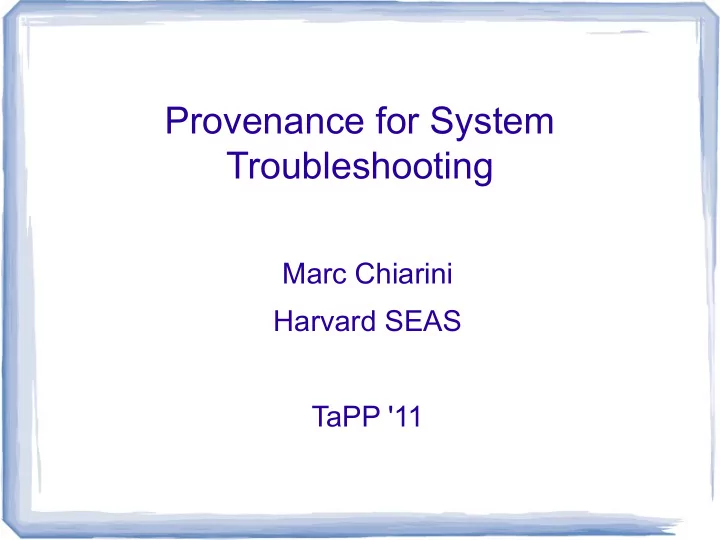

Provenance for System Troubleshooting Marc Chiarini Harvard SEAS TaPP '11
A Day in the Life... ● Wake up 3am via page from a heartless machine: hot backup has failed. ● Start troubleshooting (in pajamas, thankfully!) ● Log files indicate unable to contact storage appliance, ¾ into backup. ● Storage appliance working fine and reachable now. ● Where to look next? (Coffee first!)
System-level Provenance ● Directed acyclic graph tells us what digital objects interacted during provenance collection, and when. ● Examples: – File F read by process P – File Z written by P – Z read by process Q – Pipe I written by Q – I read by process R
Potential Dependency ● Define dependency as the transmission of information from a passive object (file, pipe, etc) to an active object (process), that is necessary to the proper functioning of the process. ● Transitive dependencies also exist between active objects. ● For troubleshooting, provenance graph edges represent potential dependencies . We don't look at data or programs, so won't talk about causality.
Troubleshooting Example dhclient.con other inputs f dhcli ent dhclient socket many endpoint other inputs D- Bus NetMan socket endpoint other inputs netw ork man ager resolv.con f resol ver
Graph Reduction ● Real graph is much too large. ● Reduction is necessary to support reasonable queries. ● Want to turn potential dependencies into actual dependencies with high confidence and eliminate non-dependencies in the graph. ● Impossible to identify all true dependencies; would require enumerating all failures.
In Our Favor... ● There are known dependencies, e.g., configuration files for system services. ● We can label with low probability, files residing in well-known log directories, e.g., / var/log. ● We can label with high probability, files residing in library directories, e.g. /usr/lib. ● We can label with high probability, files that are opened by a program on every
Other challenges ● Building a tool that improves the sysadmin's mental model of her systems via exploration, documentation, visualization, etc. ● Give the sysadmin an intuitive way to query the provenance graph and limit the scope of query responses (regexps may not cut it!). ● How do we integrate troubleshooting workflow artifacts (e.g., past symptoms and graph query results) with troubleshooting
Questions? Prototype will be available in late fall 2011. http://www.eecs.harvard.edu/syrah/pass/ chiarini@seas.harvard.edu
Recommend
More recommend